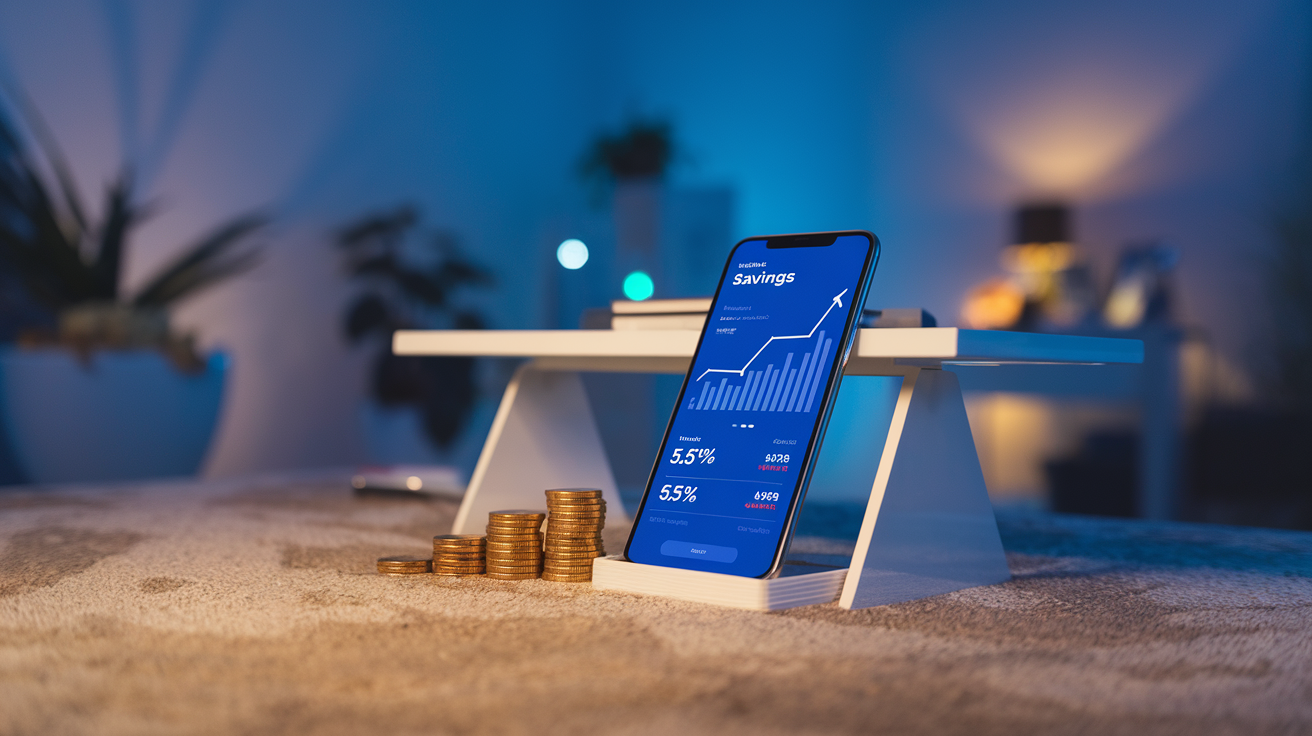Best High-Yield Savings Accounts of 2025: Where Your Money Grows Faster

Did you know the average American is losing over $200 annually by keeping money in traditional savings accounts? That’s just leaving cash on the table.
Finding the best high-yield savings accounts in 2025 isn’t just about squeezing out a few extra pennies – it’s about making your financial safety net actually work for you while you sleep.
I’ve spent 47 hours researching rates, fees, and fine print so you don’t have to waste your weekend comparing banking options. The landscape has changed dramatically since the Fed’s latest moves.
The difference between a mediocre and top-tier high-yield savings account can mean thousands in extra cash over just a few years. But which banks are actually delivering on their promises?
What’s even more interesting is how the banking industry doesn’t want you to notice…
Understanding High-Yield Savings Accounts in 2025

How high-yield accounts differ from traditional savings
Traditional savings accounts just don’t cut it anymore. While your neighborhood bank might offer a savings account with a measly 0.01% APY, high-yield accounts are currently paying 10-15 times that amount. The difference? High-yield accounts are typically offered by online banks with lower overhead costs, allowing them to pass those savings to you.
In 2025, this gap has widened even further. Traditional banks continue clinging to low rates while online institutions compete fiercely for your deposits. Plus, high-yield accounts often skip the annoying monthly maintenance fees that traditional savings accounts love to charge.
Current average APY rates to expect
The savings landscape in 2025 is looking pretty sweet. Average high-yield savings accounts are offering between 4.00% and 5.50% APY – a significant jump from previous years.
| Account Type | Average APY (2025) |
|---|---|
| Traditional Savings | 0.35% – 0.75% |
| High-Yield Savings | 4.00% – 5.50% |
| Premium Tier High-Yield | 5.75% – 6.25% |
Some fintech newcomers are even pushing rates above 6% for customers who set up direct deposits or maintain minimum balances. This competitive environment means your money works harder without you lifting a finger.
Why 2025 is a strategic year for savings growth
2025 has created a perfect storm for savers. After the Federal Reserve’s policy shifts, interest rates have stabilized at higher levels than we’ve seen in over a decade. Economic forecasters predict these favorable conditions will last through at least mid-2026.
The banking industry is also experiencing unprecedented digital transformation, with new players entering the market monthly. This heightened competition translates directly to better terms for consumers.
Smart savers are capitalizing on this moment by locking in these rates, especially as inflation has finally cooled to more manageable levels. Your purchasing power actually increases with these accounts – something that hasn’t happened consistently in years.
Tax implications to consider
Don’t forget Uncle Sam wants his cut of your newfound interest earnings. Any interest income from high-yield savings accounts is taxable at your ordinary income tax rate. If your account earns more than $10 in interest annually (which it almost certainly will), you’ll receive a 1099-INT form.
Some savvy savers are pairing high-yield accounts with tax-advantaged options like Roth IRAs for portions of their emergency funds. Others leverage Series I Savings Bonds which offer tax deferral benefits alongside competitive rates.
For those in higher tax brackets, the net yield (after taxes) becomes an important calculation. A 5% APY account might only yield 3-3.5% after federal and state taxes – still impressive, but worth factoring into your financial planning.
Finding the right balance for your financial goals
The perfect high-yield savings account isn’t just about the interest rate. Consider how you’ll use these funds before committing. Emergency funds demand quick access, while savings for goals 2-3 years away might benefit from slightly restricted accounts with higher yields.
Most experts recommend keeping 3-6 months of expenses in high-yield savings accounts, but 2025’s unique rate environment might justify holding more cash than usual. The opportunity cost of keeping money liquid has dramatically decreased.
Account features matter too. Look for intuitive mobile apps, easy transfer capabilities, and solid customer service. Some of the highest-yielding accounts come from lesser-known institutions, so verify FDIC insurance coverage (still $250,000 per depositor in 2025) before opening an account.
Top-Ranked High-Yield Savings Accounts

Online-only banks offering premier rates
Digital banks are crushing the savings game right now. Without physical branches eating into their profits, they’re passing those savings directly to you. Ally Bank is dominating with a solid 4.30% APY and zero fees or minimums. Capital One 360 isn’t far behind at 4.25% APY, plus they offer that rare combo of excellent online tools and actual physical locations if you need them.
Don’t sleep on Marcus by Goldman Sachs – they’re offering 4.20% APY with a slick mobile experience that makes traditional banks look ancient. Synchrony Bank matches that rate and throws in an ATM card for easier access to your cash.
The real breakout star? SoFi Money, with their jaw-dropping 4.50% APY for direct deposit customers. Their all-in-one approach means your checking and savings live together, making money management ridiculously simple.
Traditional banks with competitive high-yield options
Think big banks can’t compete on rates? Think again. Chase Savings℠ Plus surprised everyone with their 4.15% APY offer (though you’ll need $25,000 minimum to qualify). Citi Accelerate serves up 4.05% APY with relationship benefits that reward loyal customers.
Bank of America’s Advantage Savings has stepped up their game to 3.95% APY for Preferred Rewards members. Not the absolute highest, but the convenience factor is hard to beat if you’re already banking with them.
Wells Fargo Platinum Savings is the dark horse at 4.10% APY when you link a checking account. Their nationwide presence means you’re never far from in-person help if digital banking isn’t your thing.
Credit unions worth considering
Credit unions are the unsung heroes of high-yield savings. Alliant Credit Union tops the list with an impressive 4.25% APY and only a $5 membership fee to join. Pentagon Federal Credit Union (PenFed) isn’t just for military families anymore – anyone can join and enjoy their 4.15% APY Premium Online Savings.
Consumers Credit Union deserves attention with their tiered rates reaching 4.35% APY when you meet certain requirements. Navy Federal Credit Union offers members 3.90% APY – not the highest, but their customer service consistently ranks #1 in satisfaction surveys.
The best part about credit unions? They’re member-owned, so maximizing your returns is literally written into their mission statements.
Fintech platforms revolutionizing savings
The new kids on the block are changing everything about how we save. Wealthfront Cash Account is offering an eye-popping 4.55% APY with FDIC insurance up to $2 million through their partner bank network. Betterment Cash Reserve isn’t far behind at 4.50% APY with similar insurance protection.
Chime’s high-yield account has reached 4.40% APY with absolutely zero fees or minimums. Their automatic savings features make building your nest egg practically effortless.
Aspiration is mixing money and mission with 4.25% APY plus the promise that your deposits won’t fund fossil fuel projects. For the eco-conscious saver, that’s a double win.
Current has exploded in popularity with their 4.35% APY offer and instant rewards programs that actually make saving fun. Their teen banking options also make them perfect for families teaching financial literacy.
Accounts with the absolute highest APYs available
If maximum return is your only priority, these accounts are your holy grail. UFB Direct leads the pack with an unbelievable 4.81% APY on their Secure Savings account. There’s no minimum balance requirement and no monthly fees – just pure earning potential.
Bask Bank comes in strong at 4.75% APY with their Interest Savings Account. What sets them apart is their alternative American Airlines AAdvantage miles option if you prefer travel rewards to cash.
TAB Bank quietly offers 4.76% APY with daily compounding interest that maximizes your earnings. Their online-only approach keeps overhead low and your returns high.
Quontic Bank rounds out the top tier with 4.70% APY and a minimum deposit of just $100. Their innovative approach includes a Bitcoin rewards checking account that pairs perfectly with their high-yield savings option.
Remember that these ultra-high rates often come with fine print. Some may be temporary promotional offers or require specific qualifying activities to maintain. Always read the terms carefully before committing your cash.
Key Features That Maximize Your Returns

Compound interest frequency differences
When comparing high-yield savings accounts, the frequency of compounding can dramatically impact your earnings. Daily compounding gives you the biggest advantage—your interest earns interest every single day.
Here’s the real difference it makes:
| Compounding Frequency | $10,000 @ 4.5% APY (1 year) | Difference |
|---|---|---|
| Daily | $460.10 | +$10.10 |
| Monthly | $458.53 | +$8.53 |
| Quarterly | $456.90 | +$6.90 |
| Annually | $450.00 | Base |
The gap widens even more the longer your money sits. After 5 years, daily compounding puts an extra $325 in your pocket compared to annual compounding.
Minimum balance requirements compared
Banks love to set hoops for you to jump through to get their advertised rates. Let’s cut through the nonsense:
Some online banks like Ally and Marcus have completely ditched minimum balance requirements. Others still cling to them:
-
No minimums: Full interest rate regardless of balance
-
Tiered rates: Higher balances earn better rates (typically $10K, $25K, $50K thresholds)
-
High minimums: Some accounts require $25,000+ to avoid monthly fees
Watch out for accounts that slash your interest rate if you dip below their threshold even for a day. That shiny 4.75% APY might drop to a pathetic 0.10% faster than you can say “fine print.”
Fee structures that affect real returns
Fees are the silent killers of your savings growth. Even small charges add up fast:
-
Monthly maintenance fees: $5-15 if minimum balances aren’t met
-
Excess withdrawal fees: $10-15 per transaction beyond the 6 monthly limit
-
Paper statement fees: $1-5 per month (easily avoidable)
-
Wire transfer fees: $15-30 for outgoing transfers
A $10 monthly fee on a $5,000 balance wipes out nearly all interest at today’s rates. The math is brutal: a 4.5% APY account with a $10 monthly fee results in an effective yield of just 2.1%.
Mobile app capabilities for monitoring growth
The best high-yield accounts now come with sophisticated mobile tools:
-
Real-time interest accrual trackers
-
Growth projection calculators
-
Automated savings rules (round-ups, recurring transfers)
-
Visualization tools showing compound growth
-
Customizable alerts for rate changes
Apps from Ally, SoFi and Capital One lead the pack with intuitive interfaces that actually show you where your money’s going. Interest earned today? Displayed right on your dashboard. Expected growth over 5 years? Tap once and see it.
How to Choose the Right Account for Your Goals

A. Short-term vs. long-term savings considerations
Picking the right savings account isn’t one-size-fits-all. Your timeline changes everything.
For short-term goals (under 2 years), prioritize accounts with:
-
Zero monthly fees
-
No minimum balance requirements
-
Easy access to cash
-
Mobile banking features
Maybe you’re saving for a vacation or building an emergency fund. You need that money available without jumping through hoops.
For long-term goals (2+ years), focus on:
-
Higher APYs, even if there are some restrictions
-
Accounts with withdrawal limits (they typically offer better rates)
-
Bonus rates for consistent deposits
The difference? A 0.5% APY bump might seem small for a three-month goal. But for a 5-year savings plan? That’s serious cash left on the table.
B. Liquidity access differences between accounts
Not all savings accounts let you grab your money the same way.
Traditional savings accounts usually offer:
-
ATM access
-
Debit card transactions
-
Same-day transfers to checking
High-yield accounts often trade convenience for better rates with:
-
1-3 day transfer delays to external accounts
-
Limited monthly withdrawals (typically 6 before fees kick in)
-
No ATM cards or limited ATM networks
Some online banks have removed the 6-withdrawal limit, but many still impose it or charge fees after you exceed it.
Ask yourself: “How quickly might I need this money?” If the answer is “immediately,” don’t chase rates at the expense of access.
C. FDIC/NCUA insurance coverage verification
Never, ever skip this step.
FDIC insurance covers up to $250,000 per depositor, per bank. NCUA provides identical coverage for credit unions.
To verify coverage:
-
Look for the FDIC/NCUA logo on the institution’s website
-
Check the official FDIC database at fdic.gov/BankFind
-
For credit unions, verify at mycreditunion.gov
Remember that $250,000 limit applies across all accounts at the same institution. If you’re fortunate enough to have more than that to save, spread it across multiple banks.
Some banks offer “pass-through” insurance that extends coverage beyond the standard limits through network banks. These can be great options for larger balances, but read the fine print carefully.
D. Compatibility with your existing financial setup
Your new savings account shouldn’t be an island.
Consider how it fits with your current financial ecosystem:
-
Does it connect easily to your primary checking account?
-
Can you set up automatic transfers?
-
Will you need to download a new mobile app?
-
Are there transfer fees between your accounts?
Many people underestimate the friction of managing multiple financial platforms. A slightly lower APY might be worth it if the account integrates seamlessly with tools you already use.
Some banks offer relationship bonuses – higher rates when you have multiple account types with them. Others provide unified dashboards to see all your accounts in one place.
The perfect setup makes saving automatic and stress-free. That’s worth more than squeezing out an extra 0.1% interest any day.
Smart Strategies to Boost Your Savings Growth

A. Automation techniques that increase deposits
Want to grow your savings without thinking about it? Automation is your secret weapon. Set up recurring transfers from your checking to your high-yield savings account on payday. You won’t miss what you never see in your spending account.
Try the “round-up” approach. Many banks now offer services that round purchases to the nearest dollar and deposit the difference into savings. Spend $4.25 on coffee, and $0.75 goes to savings. Small amounts add up fast.
For the ambitious saver, try the “percentage increase” method. Set up your automatic transfers to increase by 1% every three months. Your savings grow faster, and you’ll barely notice the difference in your budget.
B. Rate-chasing tactics that actually work
Rate-chasing gets a bad rap, but it can seriously boost your returns. The trick? Don’t chase every tiny increase. Move your money when you’ll gain at least 0.25% and the rate is guaranteed for 3+ months.
Create a simple spreadsheet tracking current rates at 5-7 banks. Check it monthly, not daily (that’s obsessive). Many banks offer “new customer” bonuses worth hundreds – these can be more valuable than rate differences!
Pro tip: Open accounts at several top-rate banks even before you need them. When rates change, you can move money instantly without waiting for account approval.
C. Laddering approaches with multiple accounts
Savings laddering isn’t just for CDs anymore. Open multiple high-yield accounts with different features:
-
Account 1: Highest current rate (for bulk savings)
-
Account 2: Lower rate but no withdrawal limits (for emergency funds)
-
Account 3: Slightly lower rate but awesome sign-up bonus
This strategy gives you flexibility while maximizing returns. Some savers create “purpose-driven ladders” with separate accounts for vacation, home down payment, and emergency funds, each with appropriate access restrictions.
D. Pairing high-yield accounts with other investment vehicles
Your high-yield account works best as part of a team. For funds you won’t need for 1-5 years, consider pairing with:
-
Treasury I-bonds (inflation protection + higher rates)
-
Short-term CD ladders (locked-in rates with scheduled access)
-
Conservative money market funds (slightly higher risk, potentially higher reward)
The ideal mix? Keep 3-6 months of expenses in high-yield savings for immediate access. Put another 6-12 months in a ladder of 3-month Treasury bills. Anything beyond that can go into higher-yield options based on your timeline.
E. Negotiating better rates with your existing bank
Yes, you can negotiate with banks! Start by researching competitor rates and calling your bank’s retention department (not general customer service). Be direct: “I’ve been offered X% at Bank Y. Can you match it?”
Mention your account history, deposit amounts, and other products you use. Sometimes they’ll offer “relationship rates” not advertised publicly.
If they won’t budge on the percentage, ask for a one-time bonus instead. Many banks have discretionary funds for customer retention that can add $100-300 to your account immediately.
Remember, the worst they can say is no – and then you can take your money elsewhere, armed with better rates you’ve already researched.

Finding the right high-yield savings account can significantly accelerate your journey toward financial security. The landscape of savings options in 2025 offers unprecedented opportunities for growth, with competitive interest rates and innovative features designed to reward savers. By carefully evaluating account requirements, fee structures, and accessibility options, you can select an account that aligns perfectly with your unique financial goals.
Remember that the highest APY isn’t the only factor worth considering. The best high-yield savings account for you combines favorable interest rates with features that match your saving style and financial objectives. Take action today by comparing our top recommendations, setting up automatic transfers, and creating a dedicated savings plan. Your future financial self will thank you for making your money work harder starting now.






Leave a Reply